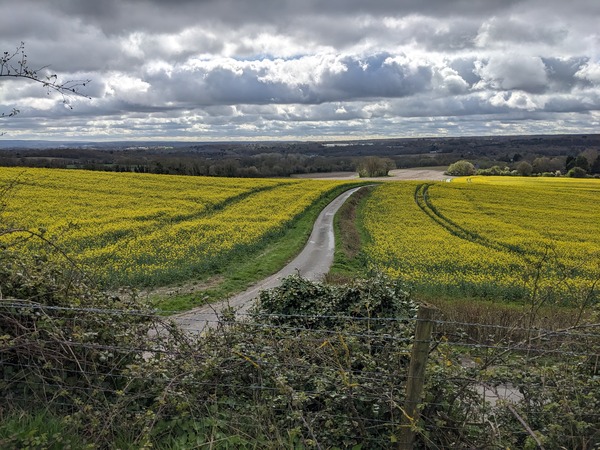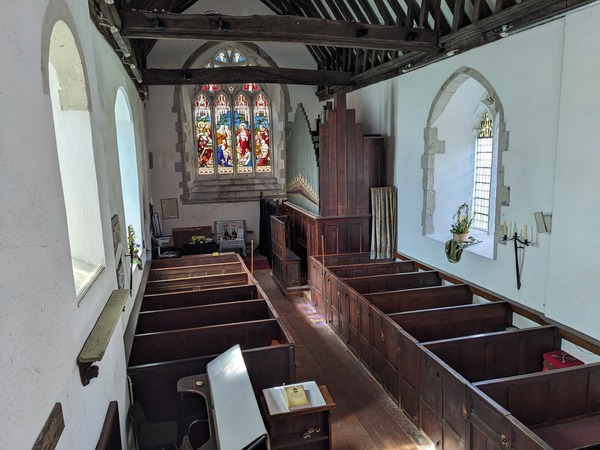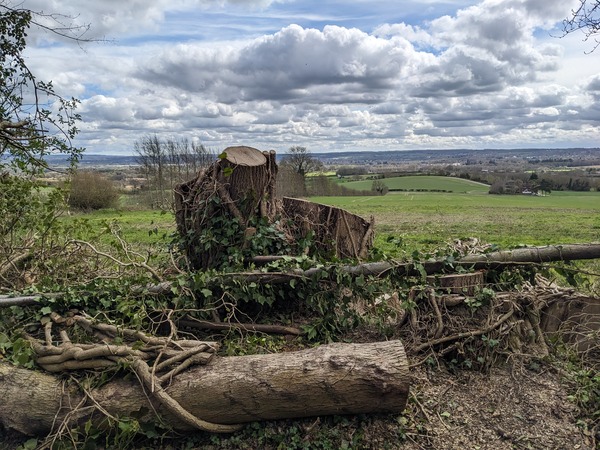I caught a train and bus to get back to Wrotham where I left off yesterday. While waiting at the station, I heard an announcement about a train strike on the day I planned to return home. This means I need to adjust my schedule.
The bus was late, and people around me mentioned these buses didn’t always turn up due to staffing issues. Thankfully, it arrived about ten minutes behind schedule.

The path initially crossed the M20 motorway. Thankfully, my single lane road, still called Pilgrim’s Way, was not near the M20 for long. Here, rapeseed was in flower in some fields. A footpath paralleled the lane and had a good view across the Medway valley, and up into the hills. I spotted some goldfinches flitting about and after a couple of miles sat down and soaked up the sun (and snacked on some open olives and tomato before they made a mess of my haversack.)
As I continued, the road became a muddy track through a woodland area. There, I encountered a rather unpleasant sight – a fox carcass crawling with bluebottles. The smell was sweet and strong. The bluebottles took off like the spine evaporating
Reaching a point where a church was visible, I considered stopping for a visit. Although it was a half-mile detour, I decided to go for it. The path leading down was a change from the hedged tracks I’d been following most of the day. This section felt more open.
Upon reaching the church, I saw a couple of men cutting the grass. I tried the door, but it seemed stuck. Disappointed, I was about to head back when I remembered a mention of a famous person buried in the churchyard according to my guidebook. Determined to find something for my half mile detour, I ask one of the men. He kindly pointed me towards the grave hidden beneath a yew tree. He said it used to be even more concealed! It was the grave of the artist, Graham Sutherland, who lived nearby.

I gave the church door another try, and this time, it opened! The interior was quite amazing, boasting a high pulpit with a crown-like structure above it. I discovered this pulpit had been in Westminster Abbey for some years before being relocated here. The old-fashioned pews with opening and closing doors added interest. They even sold Pilgrim’s jam at the back (although I couldn’t take any with me).
Following the tradition mentioned on a brass plaque by the door, I offered a prayer for the church and its minister before leaving. I got a stamp in my passport. What a turnaround from a seemingly closed church!

The path continued with another climb across a ploughed field to a lane. There, a postbox – elaborately decorated with yarn for Easter – was being examined by a dad and three youngsters. I didn’t see many people on the path.

Back on the track, I reached White Horse Wood. While the picture in my guidebook showed a path with a beautiful arch of trees in full leaf, it wasn’t quite as complete yet. Worse was to come with the sight of chopped timber throughout the area. A sign explained it was due to Ash dieback disease. It is a real heartbreaker. Seeing all those fallen trees. Ash trees would have been there for medieval pilgrims, and now they are gone.
The cleared trees provided easier glimpses across the Medway valley as I continued. Finally, I reached the town of Upper Halling, perched on a white cliff. The descent to Lower Halling was next to a fenced off quarry. I got the train from there back to Maidstone.